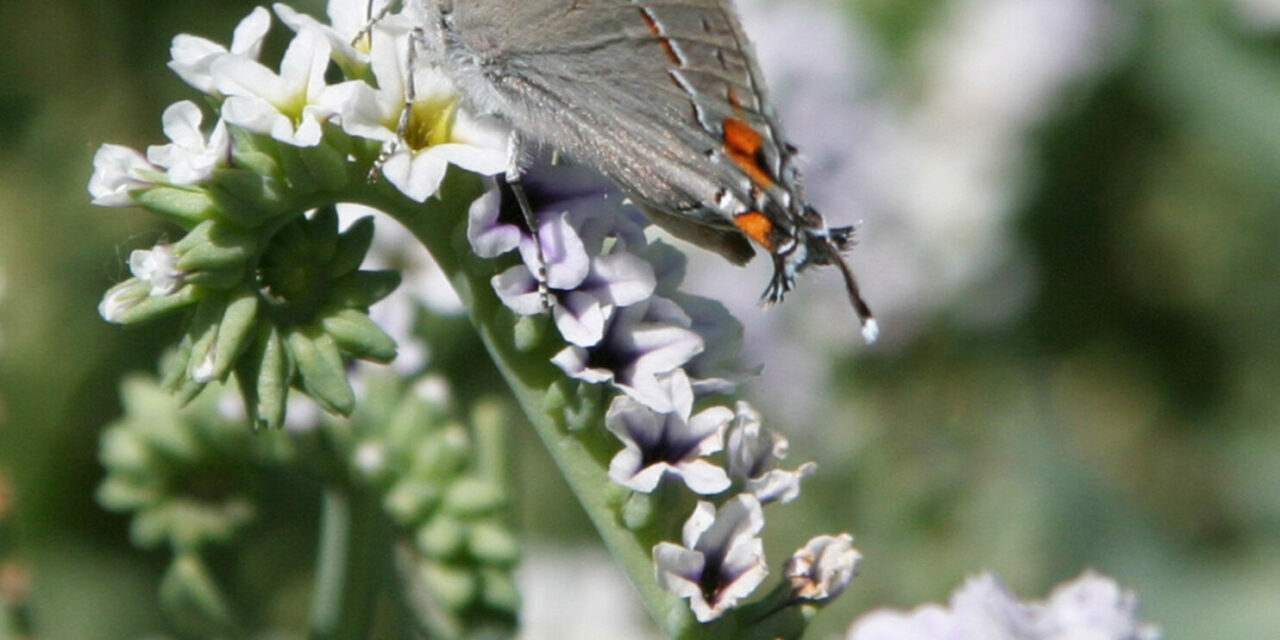There are more than 165,000 known species of these critters in the world (82 in Merced County) and they thrive on every continent except Antarctica.
Butterflies, moths and skippers, all members of the order Lepidoptera, are flitting about almost everywhere this time of year and have been since the first flowers opened in early spring. A major pollinator of native flora, the winged insects are after nectar, sap and other liquids produced by flowers and other plant parts.
Having no ability to bite or chew butterflies and moths gather nutrients through a tube-like tongue called a proboscis. Unlike other animals with an appendage of the same name such as elephants, tapirs and, in an earlier time, Jimmy Durante, butterflies store their long tongues by coiling them tightly when not in use.
The Wallace’s sphinx moth in Madagascar holds the record for the world’s longest proboscis at a full 12 inches. It needs all that tubing to reach the nectar of the night flowering Madagascar star orchid which keeps its nectar at the base of a deep trumpet-shaped flower.
Long tongues aren’t the only oddity claimed by Lepidopterans. Their eyes can have as many as 6,000 lenses and can see in the ultraviolet range of light. They also can taste with their feet allowing female flyers to taste a leaf they’re considering laying eggs on to sense if the plant will taste good to its young.
Most remarkable to the Order generally is its members’ ability to change at a cellular level from being a leaf munching caterpillar to being a beautiful flying insect. The process is called metamorphosis and it’s not a metaphorical Gregor Samsa mind trip, it’s the real deal.
The female moth or butterfly selects a suitable plant on which she lays her eggs, some species lay just a few some lays dozens. Hatching from those eggs are caterpillars which after consuming their eggshell begin munching on the leaves of whichever plant they’re on. The caterpillars are eating machines that can decimate entire fields of alfalfa, cabbage, tomatoes and other food crops as well as plants that go unnoticed to all but those who might be looking.
The caterpillar eats so much it outgrows its skin and must shed it several times as it grows. At some point the dwindling amount of a certain hormone tells the caterpillar to stop eating and causes its skin to harden forming a chrysalis or pupa around the caterpillar. Moths may add another layer of protection by spinning a cocoon.
Ater a period of time, which varies by species and climate, the chrysalis breaks open and a mature butterfly or moth emerges. It dries its wings and flies off to eat, mate and start the cycle all over again. Scientists have been observing metamorphosis for decades and still don’t really understand the process.
There are several ways to distinguish between a moth and a butterfly. Moths lay their wings flat when at rest, butterflies fold them vertically over their body. Butterflies are most active during the day; moths prefer twilight and night. Butterflies are generally more brightly colored than moths, although the striking patterns of the local, white-lined sphinx moth offer an exception. A butterfly’s antennae are single stems with a club end. Moths have filamentous antennae.
Skippers are the fastest flying of local Lepidopterans and are considered separately from moths and butterflies because their appearance has similarities to both of their cousins.
Many species of butterflies and moths make their home on the wildlife refuges of the San Luis NWR Complex. This is the time of year to see them fluttering from flower to flower on their hunt for nectar and pollen.
The iconic monarch butterfly breeds here in the San Joaquin Valley during the summer as the population migrates north to Washington and east across the Sierra Nevada to Nevada and other western states to the Rocky Mountains. Female monarchs search for native narrowleaf milkweed (found throughout the refuge complex) on which to lay their eggs.
Milkweed is the only plant on which monarchs will lay their eggs since toxic compounds within the plant impart protection to the caterpillars, and later to the butterfly, making it unlikely they will be consumed by bird predators. Monarch butterflies return to the Valley by mid-October when the population migrates back to the Pacific coast to spend the winter.
The Merced National Wildlife Refuge which is located at 7430 West Sandy Mush Road, the San Luis National Wildlife Refuge and the San Joaquin River National Wildlife Refuge comprise the San Luis National Wildlife Refuge Complex. Its headquarters and visitor center are located just north of Los Banos off Highway 165 at 7376 South Wolfsen Road.
The refuges are open to visitors daily from one half-hour before sunrise to one half-hour after sunset. The visitor center is open Monday through Friday except federal holidays from 8 a.m. to 4:30 p.m.
For more information call 209 826-3508 ext. 127.

